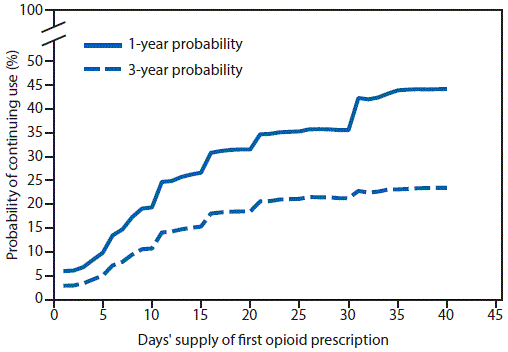Substance Use Disorder
Blog Post
A Frightening Chart on Opioids
The danger of that first prescription
“Just in case,” the oral surgeon said, as he prescribed the opioid hydrocodone for my 17-year-old son, who just had his wisdom teeth out. “But you might try Motrin first,” he added. Not knowing what the next hours, or days, would bring, we filled the prescription for 20 pills. We’d heard that the pain on the second day might be worse than the first.
I imagined similar conversations happening across the country, thousands of times a day, when I saw this chart from a new CDC report, Characteristics of Initial Prescription Episodes and Likelihood of Long-Term Opioid Use – United States, 2006-2015:

In this study of nearly 1.3 million commercially insured adults, the probability of long-term opioid use increased most sharply in the first days of therapy, particularly after five days. Even a one-day supply carries a measurable risk (6%) of continued use. A second prescription or refill doubles the risk for opioid use one year later.
Members of the Penn Opioid Task Force are trying to understand these prescribing patterns and their determinants. Using pilot funds from LDI and CHERISH, a team let by Kit Delgado is studying physician group-level variation in opioid prescribing in the emergency department and across multiple specialties.
We never used the opioids prescribed for my son—and now, like many other families, we face the challenge of disposing of them properly. Given the mounting evidence of the danger of even one prescription, “just in case” is not a compelling reason to prescribe opioids after minor injuries or procedures.